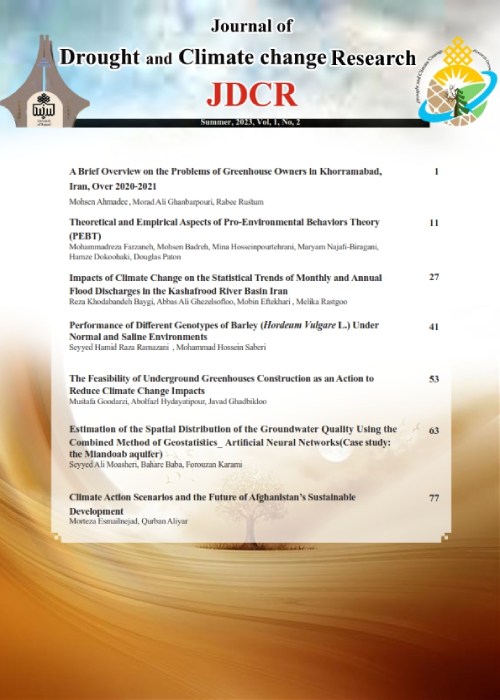فهرست مطالب

نشریه پژوهش های خشکسالی و تغییر اقلیم
پیاپی 2 (Summer 2023)
- تاریخ انتشار: 1402/06/01
- تعداد عناوین: 7
-
Pages 1-9
In recent years, greenhouse production in Khorramabad, Iran, has suffered severely from problems such as the Corona pandemic, declining average annual rainfall, and severe inflation. On the other hand, the greenhouse development policy in this city is considered to grow 3.16 times more than the present condition for the next four years. This study aims to study the main problem of greenhouse production and development in this city in 2021. To do that, field study was conducted and data were collected with interviews and direct observations. Then, all greenhouses were divided into three categories; A, B and C, based on characteristics such as type of products, cultivation bed and irrigation system. Results showed that in Type A greenhouses, which produce rose flowers, there are problems caused by Covid-19 (35%) and something else (65%), including a lack of technical staff, insufficient financial and legal knowledge, and equipment. In greenhouse type C, which produces vegetables, there was only the problem of equipment. The water crisis was not observed in greenhouses A and C and may not be encountered in the near future due to mechanized irrigation equipment and the use of recycled water systems. On the other hand, greenhouses type B, which mainly produce medicinal plants and vegetables, will face a water crisis (35%) and a lack of technical staff (65%) in the near future.
Keywords: Covid Pandemic, Greenhouse Problems, Khorramabad, Water Crisis -
Pages 11-26Title: Theoretical and Empirical Aspects of Pro-Environmental Behaviors Theory (PEBT) Several socio-psychological theories, such as the Theory of Planned Behavior (TPB), have been used to understand better the factors that explain water and resource consumption decisions. Although this theory is more frequently applied based on the interaction between people’s attitudes, behavior, subjective norms, and personal control to undertake actions, it lacks non-cognitive components. To fill this gap, this study aims to develop a comprehensive theory by leveraging appropriate non-cognitive and cognitive components considering the systematic relation between factors affecting environmental behavior and the socio-cultural context. TPB is significantly developed to Pro-Environmental Behavior Theory (PEBT) in this study. Testing the model in some empirical studies, the authors claim that the model can increase the predictive capacity of environmental behavior. Keywords: pro-environmental behavior theory (PEBT), non-cognitive components, cognitive components. . . . . . . . . . . . . .Keywords: pro-environmental behavior theory (PEBT), non-cognitive components, cognitive components
-
Pages 27-40The planet's climate has lost its balance in recent decades, so the issue of climate change has attracted much attention In the study of climate change, long-term statistics can show changes to a large extent. The purpose of this study was to investigate the statistical trend of monthly and annual series, flood discharge of Kashafrood river basin . Therefore, the statistical data of the last 65 years related to the monthly and annual series of the station were examined. Mann-Kendall test was used to check whether it was random or non-random, for the trend, type and time of change, which was observed in 5 months of the year increasing trend and in 7 months of sudden jump. Linear regression method was used for correlation of dependent and independent variables, which in most months, moderate or weak correlation was observed. Mann-Whitney and Kruskal-Wallis tests were used to evaluate the significance of jump points, which were significant in most months except November and June.Keywords: Climate change, Flood, Kashafrood, Mann-Kendall, Mann-Whitney, trend
-
Pages 41-52
,In this study, two experiments were conducted to compare the performance of eight different genotypes, their correlations, path analysis, and select the best genotype/genotypes of barley in two environments including normal and saline environments in South Khorasan province of Iran in 2015-2016. Results of combined analysis of variance for combined data of both studied environments showed significant effects for the genotype treatment on most of the studied traits. Means comparison data indicated that the highest and the lowest means of majority of investigated characteristics of barley genotypes were related to Salt4 and MBS-90-10 genotypes, respectively. Number of days to maturity and plant height had the highest simple correlation with grain yield in investigated genotypes of barley but these correlations were not significant. In forward regression analysis for grain yield as independent variable, five traits including one-thousand grain weight, number of days to maturity, mean grain weight, canopy temperature, and plant height entered to regression model in five steps with R-square=0.99. The path coefficient analysis based on grain yield, as a dependent variable implicated that number of days to maturity had the highest positive direct effect on grain yield of investigated genotypes of barley. The highest positive indirect effect on the grain yield was related to the mean grain weight trough the number of days to maturity; therefore, these two traits were the most important phenological and morphological characteristics that affect grain yield of barley under two studied environments and can used as selection criteria in investigated genotypes of barley.
Keywords: Barley, Correlation, Grain yield, Path analysis, Salt stress -
Pages 53-62In this study, as an action to reduce energy consumption and mitigate climate change impacts, creating a safer greenhouse structure, reducing the cost of construction and better management of greenhouses, the use of underground greenhouses (below ground level) in the Arak city climate, has been evaluated. To perform this experiment, three greenhouse units were built in 0, 1.5 and 2.5 meters below the ground level. The results showed that the differences in the temperature, relative humidity and radiation intensity in all three greenhouses were significant, so that in the greenhouses below the ground level there is more temperature stability and more relative humidity, but the intensity of radiation is less. Furthermore, the results of comparing the crop yield in the two seasons showed that the yield difference between zero ground and 2.5 meters below the ground level greenhouses was significant, but with the zero ground and 1.5 meters below the ground level was not significant. The results showed 5 and 6.5 percent reduction in electricity and gas energy consumption in 1.5 meters below the ground greenhouses, respectively. Also, results indicated 13.3 and 14.5 percent reduction in electricity and gas energy consumption in 2.5 meters below the ground greenhouses, respectively. The results of this study showed that if the correct locating, design and implementation of underground greenhouses are done properly, they have several advantages that distinguish these greenhouses from conventional zero ground greenhouses and therefore is a good action for climate change adaptation.Keywords: Underground Greenhouse, energy consumption, Nexus, Climate change, Arak
-
Pages 63-76
Drought crisis, although traditionally limited to central provinces, desert, and hot and dry places, but recent research has shown that in recent years, the plains of the Lake Urmia, such as the Miandoab plain, have been affected by drought, and has undergone a sharp decline in groundwater levels and subsequently reduced quality. n this research, the rate of variation in quality parameters of groundwater such as TH, TDS, EC, pH, SAR, which was collected by the regional water company of West Azarbaijan in the years 2002 and 2011, has been investigated. The statistical data of 2002 were mapped by statistical and Kriging method and stored in a regular grid of 31 * 26 in GIS software. This data is stored as a text file and used in the simulation of the artificial neural network. The results showed that the MLP model with M6 structure has a correlation coefficient of 0.92 and a mean square error of 0.562, and it can simulate groundwater quality in Mianodab Plain. Also, in predicting values of the absorption sodium ratio between 2003 and 2011, the correlation coefficient showed 0.69 satisfactory results. Finally, with sensitivity analysis, respectively, chlorine, acidity, and phosphate have the greatest effect on simulation and prediction of sodium adsorption rates.
Keywords: Prediction, Geostatistics, Artificial neural network, Sodium Absorption Ratio, Miandoab -
Pages 77-86Afghanistan is one of the worst affected of the climate change impact. Integrating climate measures and sustainable development goals into research and innovation can improve Afghanistan's future prospects. The effects of climate change lead to a lack of water and food, disease, unemployment, etc. Migration, poverty, tensions in the field of resources, and instability in Afghanistan and the world. The purpose of this study is to identify climate action companies for the sustainable development of Afghanistan. Descriptive-analytical method and using climate data and models to investigate the main strategies in the field of adaptation and reduction of the effect of climate change in Afghanistan. stainable development Estimating the drivers and assumptions of four global 2050 climate change scenarios by the Joint Research Center (JRC), Science Service and the knowledge of the European Commission in 2021, climate change scenarios and the future of sustainable development in Afghanistan in the horizon of 2050 with the titles: 1. scenario First: Dream Afghanistan; 2. Second scenario: Afghanistan on the way to sustainability; 3. The third scenario: unstable Afghanistan; 4. The fourth scenario: Afghanistan in difficult conditions, edited became. Afghanistan’s Climate Change Strategy and Action Plan should be urgently finalized and implemented as a primary step towards mainstreaming climate change into national development plansKeywords: climate Action, Afghanistan, Scenario, Sustainable development


